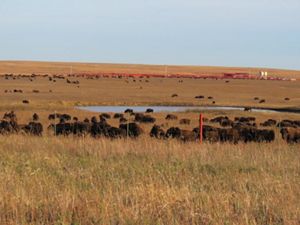It's Time for Action on Grasslands
The North American Grasslands Conservation Act will help bring people and nature together.
Grasslands are the most threatened, least protected habitat on Earth—more at risk than the Amazon rainforest.
That’s why The Nature Conservancy is pleased to join more than 45 organizations supporting the North American Grasslands Conservation Act.
The prairies in the central U.S. are an iconic American landscape. They are home to buffalo, elk and pronghorn (the fastest mammal in North America), hundreds of species of grassland birds, more than 1,000 different native plants, as well as countless pollinators like the monarch butterfly. Grasslands also benefit us tremendously by providing food, clean water, carbon storage and sequestration, erosion and flood control. And they are remarkable places to see wildflowers, hike, hunt, bird or watch wildlife.

Unfortunately, we’re losing grasslands faster than we are able to protect or restore them. As an example, more than 95% of the tallgrass prairie has been lost, making it the most altered ecosystem in North America in terms of acres lost. Overall, more than 70% of America’s original prairies have vanished. Most of what remains is in private ownership. Cattle help keep ranchers in business and our remaining grasslands intact.
Throughout the Great Plains, ranchers play a critical role in conserving and managing grasslands, along with Native Nations, local, state and federal government and conservation organizations including TNC.
That’s why I’m so encouraged that in October 2024 a group of bipartisan lawmakers—Nancy Mace (R-S.C.), Sharice Davids (D-Kan.), Brian Fitzpatrick (R-Pa.) and Mike Thompson (D-Calif.)—introduced the Grasslands Act in the U.S. House of Representatives.
Quote: Ben Postlethwait
The Grasslands Act would kickstart the voluntary protection and restoration of grasslands – and the livelihoods and wildlife dependent upon them.
Ranchers are doing their part to keep their land unbroken, in production and on the tax rolls. But economic factors make ranching a challenging business.
The Grasslands Act would kickstart the voluntary protection and restoration of grasslands—and the livelihoods and wildlife dependent upon them.
Functionally, the legislation is modeled after the successful North American Wetlands Conservation Act (NAWCA) and would create a landowner-driven, voluntary, incentive-based program to conserve America’s critically imperiled grasslands.
There’s urgency to conserve our grasslands for present and future generations while supporting ranchers, Native Nations, hunters, birders and rural communities.

Protecting our grasslands will not only preserve our natural resources, but it will also maintain a way of life for Indigenous people and rural communities that rely on them.
My family and I love the outdoors and we often spend our weekends exploring rivers, rocks, and trails together in the Great Plains. We want everyone to be able to experience and enjoy the region’s grasslands as much as we do.
We need everyone who lives, works and plays in the region to support the North American Grasslands Conservation Act. We can bring landowners, producers and policymakers together, and ensure the Great Plains lives up to its name.
We Can’t Save Nature Without You
Sign up to receive regular updates from The Nature Conservancy.









